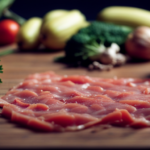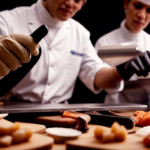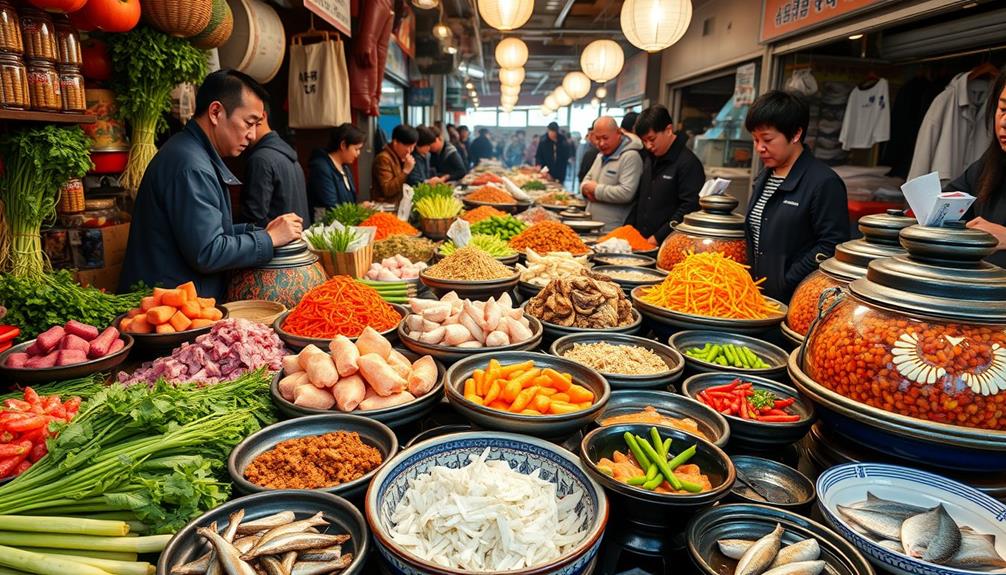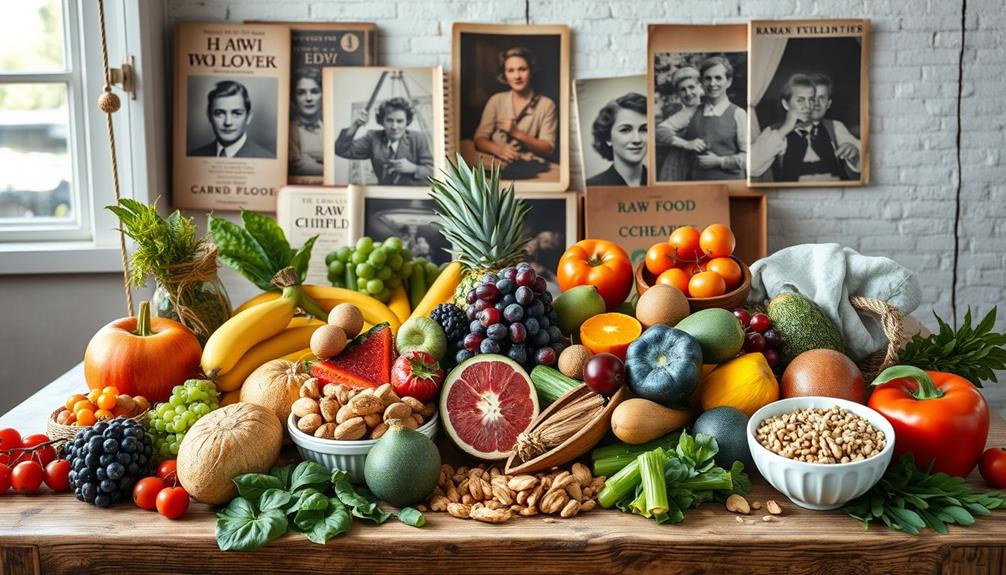Bacteria can spread from raw food in mere seconds, posing a serious health risk if not properly managed. In the temperature danger zone (40°F to 140°F), bacteria can double every 10 to 20 minutes, making careful handling essential. High-risk foods like raw meats and certain vegetables are particularly vulnerable. It's important to minimize contact time and maintain clean surfaces to prevent cross-contamination. Effective practices include using separate cutting boards and sanitizing surfaces after handling raw items. By understanding these risks and implementing safety measures, you can protect yourself and others. There's a lot more to evaluate for food safety.
Key Takeaways
- Bacteria can spread rapidly from raw food, often within seconds of contact with surfaces or other foods.
- A contact time of 30 seconds or more significantly increases the transfer of bacteria, potentially up to 97%.
- The temperature danger zone (40°F to 140°F) allows bacteria to double every 10 to 20 minutes, accelerating contamination.
- Approximately 12% of foodborne outbreaks are linked to surface cross-contamination, highlighting the need for safe handling practices.
- Effective handwashing and sanitizing surfaces can significantly reduce the risk of bacterial spread from raw food.
Understanding Bacterial Contamination
Bacterial contamination is a widespread issue that can lead to serious health risks. When bacteria multiply on food, they can cause spoilage and result in foodborne illnesses. Symptoms typically appear within 24 hours to several days after consumption, depending on the type of bacteria involved.
It's essential to select the right food safety practices to minimize risks, as improper handling can exacerbate contamination issues, similar to the significance of selecting the right cold medication for effective relief.
The main types of foodborne illnesses include food intoxication, which is caused by toxins produced by bacteria like Staphylococcus aureus, and food infection, stemming from live bacteria such as Salmonella.
High-risk foods, including raw meats, poultry, dairy products, and certain vegetables, are particularly susceptible to bacterial contamination due to their high moisture, starch, or protein content.
Bacteria can double in number every 20 minutes when food remains in the temperature danger zone, which ranges from 40°F to 140°F. Additionally, cross-contamination plays a significant role in spreading bacteria, often occurring when bacteria transfer between different surfaces and foods.
This highlights the significance of strict food safety practices to prevent bacterial spread and protect your health. Being aware of these factors can help you avoid foodborne illnesses and guarantee safe food handling in your kitchen.
Factors Influencing Bacterial Growth
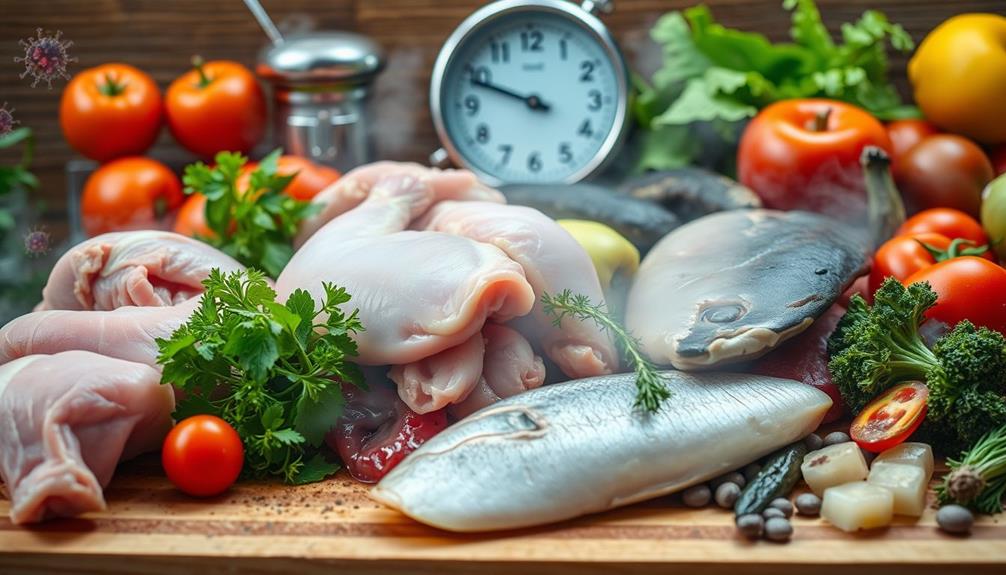
Understanding the factors influencing bacterial growth is vital for maintaining food safety. Several key elements can accelerate bacterial contamination, particularly in food.
| Factor | Description | Impact on Bacteria |
|---|---|---|
| Temperature | Bacteria can double every 10 to 20 minutes in the danger zone (40°F to 140°F). | High risk of contamination. |
| Moisture Content | High moisture in foods like raw meats and dairy creates an ideal environment for growth. | Promotes spoilage. |
| Acidity Level | Low pH foods inhibit bacterial growth more effectively than neutral or high pH foods. | Safer food options. |
| Oxygen Levels | Reduced oxygen in vacuum-packed foods slows bacterial growth considerably. | Decreases spoilage rate. |
The initial microbial load also plays a vital role. If food starts with a high amount of bacteria, the risk of contamination increases in favorable conditions. By recognizing these factors, you can implement better food safety practices and reduce the likelihood of foodborne illnesses. Always keep food at safe temperatures, monitor moisture levels, and consider acidity to minimize bacterial growth effectively.
Speed of Bacterial Spread

The speed at which bacteria can spread in food environments is alarming, especially when raw foods are involved. Bacterial contamination can occur quickly, often within seconds. Once raw food touches surfaces, the risk of cross-contamination skyrockets, allowing harmful bacteria to transfer to other foods or surfaces almost instantaneously.
For example, certain foods like ice cream can pose additional health risks if not handled properly, as they may expose individuals to higher sugar and fat content, making them more susceptible to health issues consider health impacts.
Here are some critical points to understand:
- Rapid Doubling: Bacteria can double in number every 20 minutes in the temperature danger zone (40°F to 140°F).
- High Transfer Rates: Watermelon, for instance, can exhibit transfer rates as high as 97% when it contacts contaminated surfaces.
- Impact of Time: If food remains in contact with contaminated surfaces for 30 seconds or more, the transfer of bacteria greatly increases.
- Outbreak Statistics: Approximately 12% of foodborne outbreaks are linked to surface cross-contamination, showcasing how quickly bacteria can spread in your kitchen.
Recognizing how swiftly bacterial spread can occur is essential for maintaining food safety. By being aware of these factors, you can take proactive measures to minimize risk.
Safe Food Handling Practices

When you handle raw food, handwashing is essential to prevent bacteria from spreading.
Additionally, it's important to regularly sanitize surfaces and utensils used for food preparation, particularly when dealing with raw ingredients.
Always use separate cutting boards for raw meats and ready-to-eat items to avoid cross-contamination.
Importance of Handwashing
Washing your hands thoroughly is an essential step in safe food handling practices. When you handle raw food, your hands can easily pick up harmful bacteria that lead to foodborne illnesses. By practicing proper handwashing, you can greatly reduce this risk.
The CDC estimates that effective handwashing can cut the spread of these illnesses by up to 50%. Additionally, just like ensuring your pets, such as hamsters, are healthy and well-cared for, maintaining hygiene in the kitchen is vital for a safe environment routine health checks.
Here are four important times you should wash your hands:
- Before preparing any food.
- After handling raw meat, poultry, seafood, or eggs.
- In between different food preparation tasks (like switching from raw meats to vegetables).
- After touching surfaces that may harbor bacteria.
Make sure to wash your hands with soap and water for at least 20 seconds. After washing, use a clean towel or air dry your hands, as damp hands can transfer bacteria more easily.
Avoiding Cross-Contamination
Hands can easily spread harmful bacteria if you're not careful, so it's essential to prevent cross-contamination in your kitchen. Bacterial contamination can occur rapidly, especially when raw foods come into contact with surfaces, utensils, or other foods. To minimize this risk, use separate cutting boards for raw meats and other food types.
Additionally, implementing proper cleaning techniques, such as those used in preventing cross-contact on prep tables, can further enhance food safety. The USDA highlights that about 12% of foodborne outbreaks stem from surface cross-contamination, so strict separation during preparation and storage is key.
Make it a habit to wash your hands and surfaces frequently with hot, soapy water. This practice helps reduce the transfer of bacteria from raw food to cooked or ready-to-eat items. Even brief contact—less than 5 seconds—can lead to significant contamination, particularly with high-risk foods like watermelon and raw meats.
Always store raw foods on the bottom shelf of your fridge to prevent drips onto other items. By staying vigilant with these safe food handling practices, you can effectively minimize cross-contamination and keep your kitchen a safe place for food preparation.
Tips for Safe Food Storage
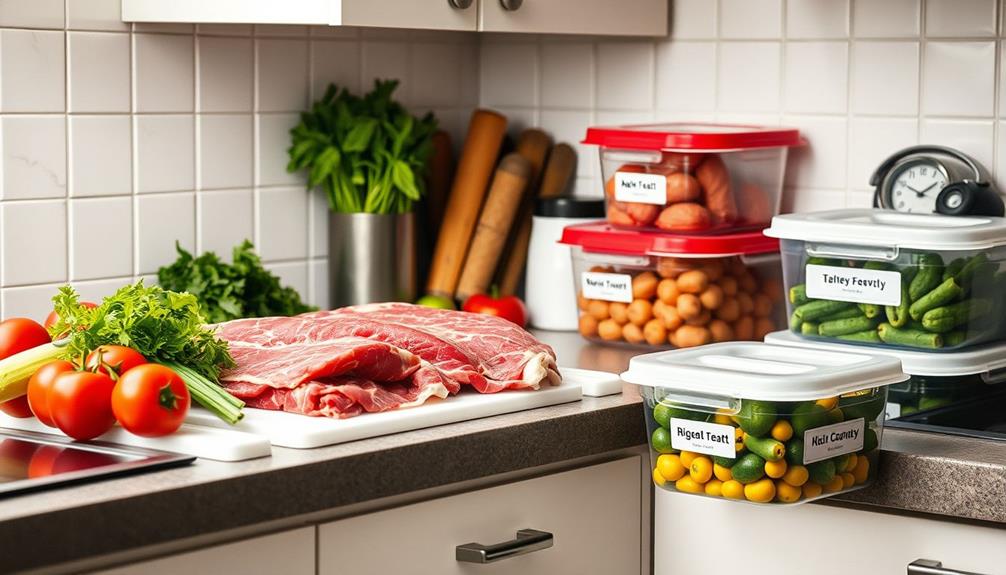
To keep your food safe and minimize the risk of bacterial contamination, proper storage is essential. Following these tips will help you manage raw meat and poultry safely and prevent cross-contamination in your kitchen:
1. Seal It Up: Store raw meat, poultry, and seafood in sealed containers or bags. This prevents harmful bacteria from leaking onto other foods in your refrigerator.
Additionally, using proper storage techniques can enhance the longevity of your food, similar to how best vacuums for dust removal can help maintain a clean environment.
2. Monitor Temperature: Keep your refrigerator temperature at or below 40 °F (4 °C). This slows bacterial growth and maintains safe food conditions.
3. Refrigerate Promptly: Make certain to refrigerate leftovers within 2 hours of cooking. Use shallow containers to facilitate rapid cooling and reduce the risk of bacterial contamination.
4. Label for Freshness: Always label containers with storage dates. Consume leftovers within 3 to 4 days to avoid spoilage and guarantee food safety.
Cooking and Reheating Guidelines
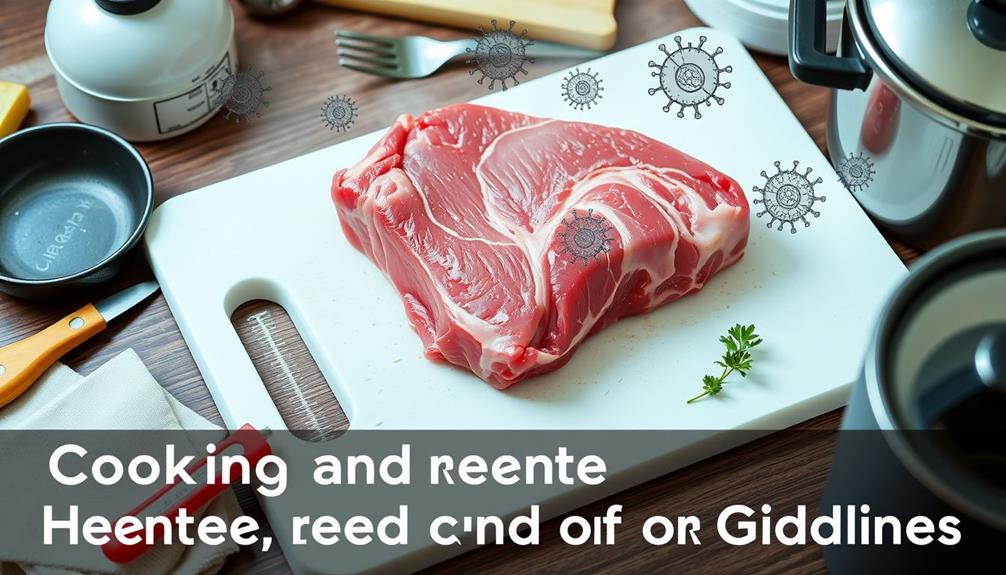
When cooking meat and poultry, you need to hit the right internal temperatures to kill harmful bacteria. Proper cooking methods and hygiene practices are essential to prevent foodborne illnesses, especially in vulnerable populations like infants and children.
For example, raw meat should reach at least 165 °F, while ground meats need to get to 160 °F. Don't forget to reheat leftovers to 165 °F, making sure they stand for at least two minutes to guarantee safe consumption.
Familiarizing yourself with newborn dietary needs can further help in maintaining safe eating practices for your family.
Safe Cooking Temperatures
Cooking food to the right temperatures is essential for eliminating harmful bacteria and ensuring your meals are safe to eat. If you don't pay attention to safe cooking temperatures, you risk foodborne illness, which can be severe.
Understanding the importance of common financial terms can help you make informed decisions about food safety investments. Here's a quick guide to help you remember the minimum internal temperatures for various foods:
- Beef, Pork, Lamb, and Veal: 145 °F
- Ground Meats: 160 °F
- Poultry: 165 °F
- Leftovers: 165 °F when reheating
It's vital to monitor these temperatures with a food thermometer. Remember, once food is in the temperature danger zone (40 °F to 140 °F), bacteria can double in number every 20 minutes.
To prevent this, don't leave food out for more than 2 hours. Cooking food above 140 °F effectively kills bacteria and prevents foodborne illness, so always be vigilant.
If you're reheating food, make sure it's hot and steaming throughout to eliminate any residual bacteria. Following these guidelines will help you keep your meals safe and delicious!
Reheating Food Properly
Reheating food properly is essential for maintaining safety and flavor. To guarantee your leftovers are safe to eat, always reheat them to an internal temperature of 165 °F. This temperature is critical for killing harmful bacteria that may have developed during storage, similar to the importance of early detection in breast cancer screening early detection methods.
When using a microwave, cover your food to help it heat evenly. It's also wise to rotate the dish during cooking to avoid cold spots. After microwaving, let the food stand for at least two minutes. This standing time allows heat to distribute, guaranteeing thorough reheating throughout the dish.
Remember, it's best to reheat leftovers only once. Repeated reheating can increase the risk of bacterial growth and compromise food quality. Always use a food thermometer to check that your reheated meals reach the necessary internal temperature before serving.
If you're reheating pre-packaged foods, follow the manufacturer's instructions for safe and effective heating. By adhering to these guidelines, you can enjoy your meals while minimizing the risk of foodborne illness.
Prevention of Cross-Contamination

Preventing cross-contamination is essential for keeping your kitchen safe and your food healthy. Bacteria can spread from raw food to surfaces or other foods in as little as one second, making it imperative to maintain cleanliness during food preparation.
Using essential oils like tea tree oil can also help reduce bacterial presence on surfaces, thanks to its antimicrobial properties.
Here are four effective strategies to help you prevent food contamination:
- Use Separate Cutting Boards: Always designate one cutting board for raw meats and another for fruits, vegetables, and other food items. This minimizes the risk of bacteria transferring between different foods.
- Clean Surfaces Frequently: After preparing raw food, clean and sanitize all surfaces. This includes countertops and cutting boards, as bacteria can linger if not properly addressed.
- Wash Your Hands: Always wash your hands thoroughly with soap and water after handling raw food. This simple step is essential in preventing the spread of bacteria.
- Limit Contact Time: Reduce the time raw food comes into contact with surfaces. The longer bacteria have to transfer, the greater the risk of cross-contamination, so clean up immediately after use.
Monitoring Food Safety
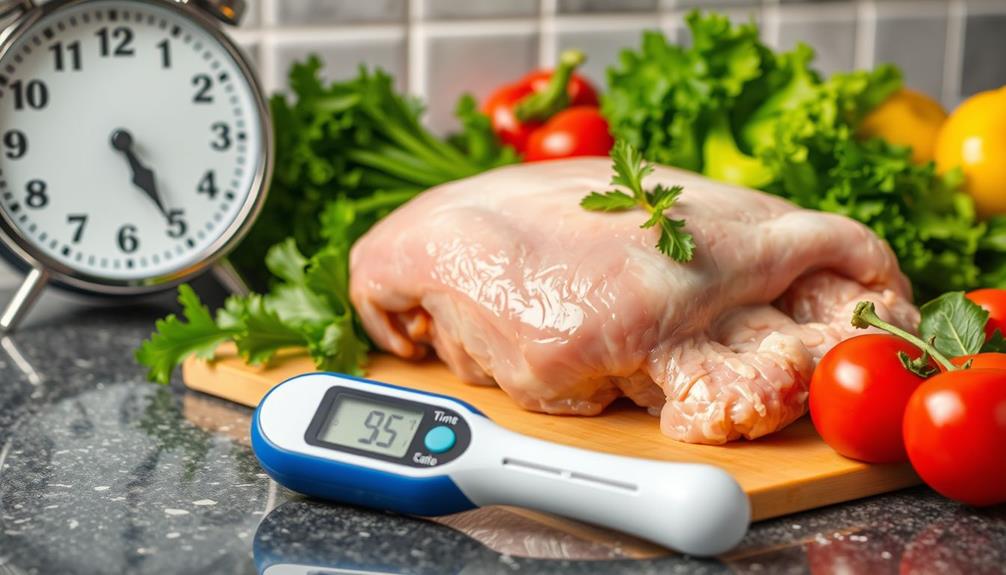
Effective monitoring of food safety is vital for preventing bacterial contamination in your kitchen. When raw food sits in the Danger Zone (40°F to 140°F), bacteria can multiply rapidly, doubling in number every 20 minutes. To combat this, keep your refrigerator at or below 40°F to slow bacterial growth. Regular temperature checks and adjustments can make a significant difference.
Additionally, maintaining a clean air environment in your kitchen by using an air purifier can help reduce airborne bacteria air purifier maintenance dos and don'ts.
Another important aspect of monitoring food safety is using separate cutting boards for raw meats and other food items. This simple step minimizes the risk of cross-contamination, a major cause of foodborne illnesses.
Additionally, don't overlook the significance of cleaning and sanitizing kitchen surfaces regularly; it can drastically reduce the chance of bacteria spreading from raw food.
Implementing a food safety management system (FSMS) can further enhance your efforts. An FSMS provides real-time monitoring and alerts for any critical limit breaches, helping you stay ahead of potential risks.
Frequently Asked Questions
How Long Does It Take for Bacteria to Spread on Food?
Bacteria can start spreading on food within 20 minutes, especially in warm environments. The type of food and surface matters too, so always practice safe food handling to minimize contamination risks during preparation. Moreover, raw food, such as unpasteurized dairy and raw eggs, can harbor harmful bacteria like Listeria, Salmonella, and E. coli, posing a significantly higher risk of foodborne illness. This is why raw food is harmful during pregnancy, as these bacteria can lead to serious complications such as miscarriage, preterm birth, or stillbirth. It is essential for pregnant individuals to be extra cautious with their food choices and handling to ensure the safety of both themselves and their unborn baby.
How Fast Can Bacteria Contaminate Food?
Imagine cutting raw chicken on a countertop. Within seconds, bacteria can transfer to your cutting board. Bacteria can contaminate food almost instantly, especially in the danger zone, so always handle food safely to prevent illness.
How Long Does It Take for Bacterial Contamination to Occur?
Bacterial contamination can happen quickly—sometimes in just seconds. If you leave food in the danger zone, it can become unsafe within 20 minutes. Always refrigerate or cook raw food promptly to prevent illness.
How Long Before Cooked Food Grows Bacteria?
Cooked food can start growing bacteria within 2 hours if it's kept in the temperature danger zone. If it's above 90°F, you've only got 1 hour before bacteria begin to multiply rapidly.
Conclusion
In conclusion, staying informed about bacterial contamination, practicing safe food handling, and monitoring food safety can protect you and your loved ones. By understanding how quickly bacteria can spread, you can make wiser choices about food storage and preparation. Remember, safe cooking and reheating practices are just as important as preventing cross-contamination. Ultimately, your vigilance today can lead to healthier meals tomorrow, ensuring that what nourishes you keeps you safe and thriving.




